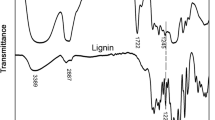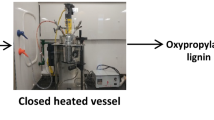Abstract
Recently, cellulose nanofibrils (CNFs) and lignin-based graphite have been explored due to their biodegradability and biocompatibility. In this study, CNFs and lignin-based graphite were used to partially replace petroleum-based polyols and fabricate novel flexible polyurethane foam (Flex-PUF) composite. The impacts of CNFs and graphite on the physical, thermal, and structural properties of Flex-PUF were systematically evaluated. Compared to graphite, the addition of CNFs had less influence on the thermal stability of Flex-PUF. The differential scanning calorimetry results revealed that replacing polyols with CNFs did not significantly change the decomposition temperature of the urea bond. However, adding 40% of graphite increased the decomposition temperature to 310 °C, while further adding graphite to 50% decreased the decomposition temperature to 240 °C. Nitrogen adsorption isotherm confirmed that the specific surface area of the foam first decreased to 99 m2/g and then increased to 175 m2/g with the increase of CNFs from 10 to 30%. However, there was an opposite trend with the respect of graphite. The specific surface area of the foam first increased to 262 m2/g and then abruptly decreased to 107 m2/g with the increase of graphite content. Water contact angle test revealed good hydrophobicity for all foam samples. Finally, promising crude oil/water separation performance was demonstrated by Flex-PUF sample functionalized with both CNFs and graphite, with fresh water passing through the foam sample, while the crude oil being held steady in the foam.
Graphic abstract








Similar content being viewed by others
References
Balandin AA, Ghosh S, Bao W et al (2008) Superior thermal conductivity of single-layer graphene. Nano Lett 8:902–907. https://doi.org/10.1021/nl0731872
Barari B, Ellingham TK, Ghamhia II et al (2016) Mechanical characterization of scalable cellulose nano-fiber based composites made using liquid composite molding process. Compos Part B Eng 84:277–284. https://doi.org/10.1016/j.compositesb.2015.08.040
Bera M, Chandravati Gupta P, Maji PK (2018) Facile one-pot synthesis of graphene oxide by sonication assisted mechanochemical approach and its surface chemistry. J Nanosci Nanotechnol 18:902–912. https://doi.org/10.1166/jnn.2018.14306
Bolotin KI, Sikes KJ, Jiang Z et al (2008) Ultrahigh electron mobility in suspended graphene. Solid State Commun 146:351–355. https://doi.org/10.1016/j.ssc.2008.02.024
Chen W, Yu H, Li Q et al (2011) Ultralight and highly flexible aerogels with long cellulose I nanofibers. Soft Matter 7:10360. https://doi.org/10.1039/c1sm06179h
Chen W, Li Q, Wang Y et al (2014) Comparative study of aerogels obtained from differently prepared nanocellulose fibers. Chemsuschem 7:154–161. https://doi.org/10.1002/cssc.201300950
Chen B, Zheng Q, Zhu J et al (2016) Mechanically strong fully biobased anisotropic cellulose aerogels. RSC Adv 6:96518–96526. https://doi.org/10.1039/C6RA19280G
Chen C, Deng S, Yang Y et al (2018a) Highly transparent chitin nanofiber/gelatin nanocomposite with enhanced mechanical properties. Cellulose 25:5063–5070. https://doi.org/10.1007/s10570-018-1915-z
Chen C, Li D, Abe K, Yano H (2018b) Formation of high strength double-network gels from cellulose nanofiber/polyacrylamide via NaOH gelation treatment. Cellulose 25:5089–5097. https://doi.org/10.1007/s10570-018-1938-5
Datta J, Balas A (2003) DSC and thermal stability investigation of novel poly(ester-ether) glycols and poly(ester-ether)urethanes. J Therm Anal Calorim 74:615–621. https://doi.org/10.1023/B:JTAN.0000005202.46487.ca
Datta J, Parcheta P (2017) A comparative study on selective properties of Kraft lignin–natural rubber composites containing different plasticizers. Iran Polym J 26:453–466. https://doi.org/10.1007/s13726-017-0534-0
Efstathiou K (2011) Synthesis and characterization of a Polyurethane Prepolymer for the development of a novel Acrylate-based polymer foam. Budapest University of Technology and Economics (BME), Budapest
Gama N, Ferreira A, Barros-Timmons A (2018) Polyurethane foams: past, present, and future. Materials 11:1841. https://doi.org/10.3390/ma11101841
Głowińska E, Datta J (2016) Bio polyetherurethane composites with high content of natural ingredients: hydroxylated soybean oil based polyol, bio glycol and microcrystalline cellulose. Cellulose 23:581–592. https://doi.org/10.1007/s10570-015-0825-6
Gunashekar S, Abu-Zahra N (2014) Characterization of functionalized polyurethane foam for lead ion removal from water. Int J Polym Sci 2014:1–7. https://doi.org/10.1155/2014/570309
Han J, Qiu W, Tiwari S et al (2015) Consumer-grade polyurethane foam functions as a large and selective absorption sink for bisphenol A in aqueous media. J Mater Chem A 3:8870–8881. https://doi.org/10.1039/C5TA00868A
Karlsson K, Schuster E, Stading M, Rigdahl M (2015) Foaming behavior of water-soluble cellulose derivatives: hydroxypropyl methylcellulose and ethyl hydroxyethyl cellulose. Cellulose 22:2651–2664. https://doi.org/10.1007/s10570-015-0669-0
Kartick B, Srivastava SK, Srivastava I (2013) Green synthesis of graphene. J Nanosci Nanotechnol 13:4320–4324. https://doi.org/10.1166/jnn.2013.7461
Khenfouch M, Buttner U, Baïtoul M, Maaza M (2014) Synthesis and characterization of mass produced high quality few layered graphene sheets via a chemical method. Graphene 03:7–13. https://doi.org/10.4236/graphene.2014.32002
Klemm D, Heublein B, Fink H-P, Bohn A (2005) Cellulose: fascinating biopolymer and sustainable raw material. Angew Chem Int Ed 44:3358–3393
Kumari S, Chauhan GS, Ahn J (2016) Novel cellulose nanowhiskers-based polyurethane foam for rapid and persistent removal of methylene blue from its aqueous solutions. Chem Eng J 304:728–736. https://doi.org/10.1016/j.cej.2016.07.008
Law K-Y (2014) Definitions for hydrophilicity, hydrophobicity, and superhydrophobicity: getting the basics right. J Phys Chem Lett 5:686–688. https://doi.org/10.1021/jz402762h
Lawrence M, Jiang Y (2017) Porosity, pore size distribution, micro-structure. In: Amziane S, Collet F (eds) Bio-aggregates based building materials. Springer, Dordrecht, pp 39–71
Leng W, Li J, Cai Z (2017) Synthesis and characterization of cellulose nanofibril-reinforced polyurethane foam. Polymers 9:597. https://doi.org/10.3390/polym9110597
Li J, Wei L, Leng W et al. (2017) Fabrication and characterization of CNF/Epoxy nanocomposite foam. J Mater Sci 53:4949–4960
Lin R, Li A, Zheng T et al (2015) Hydrophobic and flexible cellulose aerogel as an efficient, green and reusable oil sorbent. RSC Adv 5:82027–82033. https://doi.org/10.1039/C5RA15194E
Liszkowska J, Czupryński B, Sadowska JP (2016) Thermal properties of polyurethane-polyisocyanurate (PUR-PIR) foams modified with tris(5-Hydroxypenthyl) citrate. J Adv Chem Eng. https://doi.org/10.4172/2090-4568.1000148
Liu Q, Jing S, Wang S et al (2016) Flexible nanocomposites with ultrahigh specific areal capacitance and tunable properties based on a cellulose derived nanofiber-carbon sheet framework coated with polyaniline. J Mater Chem A 4:13352–13362. https://doi.org/10.1039/C6TA05131F
Lvov Y, Guo B, Fakhrullin RF (2016) Functional polymer composites with nanoclays. Royal Society of Chemistry, London
Marcovich NE, Auad ML, Bellesi NE et al (2006) Cellulose micro/nanocrystals reinforced polyurethane. J Mater Res 21:870–881. https://doi.org/10.1557/jmr.2006.0105
Medjahdi M, Benderdouche N, Bestani B et al (2016) Modeling of the sorption of crude oil on a polyurethane foam-powdered activated carbon composite. Desalination Water Treat 57:22311–22320. https://doi.org/10.1080/19443994.2015.1129511
Meng Y, Wang X, Wu Z et al (2015a) Optimization of cellulose nanofibrils carbon aerogel fabrication using response surface methodology. Eur Polym J 73:137–148. https://doi.org/10.1016/j.eurpolymj.2015.10.007
Meng Y, Young TM, Liu P et al (2015b) Ultralight carbon aerogel from nanocellulose as a highly selective oil absorption material. Cellulose 22:435–447. https://doi.org/10.1007/s10570-014-0519-5
Morozov SV, Novoselov KS, Katsnelson MI et al (2008) Giant Intrinsic carrier mobilities in graphene and its bilayer. Phys Rev Lett. https://doi.org/10.1103/PhysRevLett.100.016602
Olsson RT, Azizi Samir MAS, Salazar-Alvarez G et al (2010) Making flexible magnetic aerogels and stiff magnetic nanopaper using cellulose nanofibrils as templates. Nat Nanotechnol 5:584–588. https://doi.org/10.1038/nnano.2010.155
Pielichowska K, Bieda J, Szatkowski P (2016) Polyurethane/graphite nano-platelet composites for thermal energy storage. Renew Energy 91:456–465. https://doi.org/10.1016/j.renene.2016.01.076
Rivera-Armenta JL, Heinze Th, Mendoza-Martínez AM (2004) New polyurethane foams modified with cellulose derivatives. Eur Polym J 40:2803–2812. https://doi.org/10.1016/j.eurpolymj.2004.07.015
Seydibeyoglu MO, Misra M, Mohanty A et al (2013) Green polyurethane nanocomposites from soy polyol and bacterial cellulose. J Mater Sci 48:2167–2175. https://doi.org/10.1007/s10853-012-6992-z
Silva TCF, Habibi Y, Colodette JL et al (2012) A fundamental investigation of the microarchitecture and mechanical properties of tempo-oxidized nanofibrillated cellulose (NFC)-based aerogels. Cellulose 19:1945–1956. https://doi.org/10.1007/s10570-012-9761-x
Silverstein RM, Bassler GC, Morrill TC (1981) Spectrometric identification of organic compounds, 4th edn. Wiley, New York
Strankowski M, Włodarczyk D, Piszczyk Ł, Strankowska J (2016) Polyurethane nanocomposites containing reduced graphene oxide, FTIR, Raman, and XRD studies. J Spectrosc 2016:1–6. https://doi.org/10.1155/2016/7520741
Szycher M (2012) Szycher’s handbook of polyurethanes, 2nd edn. CRC Press, Boca Raton
Tan L-L, Ong W-J, Chai S-P, Mohamed A (2013) Reduced graphene oxide-TiO2 nanocomposite as a promising visible-light-active photocatalyst for the conversion of carbon dioxide. Nanoscale Res Lett 8:465. https://doi.org/10.1186/1556-276X-8-465
Twigg MV, Richardson JT (2002) Theory and applications of ceramic foam catalysts. Chem Eng Res Des 80:183–189
Wang M, Anoshkin IV, Nasibulin AG et al (2016) Electrical behaviour of native cellulose nanofibril/carbon nanotube hybrid aerogels under cyclic compression. RSC Adv 6:89051–89056. https://doi.org/10.1039/C6RA16202A
Yang H (2019) Graphite R050503–RRUFF database: Raman, x-ray, infrared, and chemistry. http://rruff.info/Graphite/R050503. Accessed 20 May 2019
Yoshimitsu Z, Nakajima A, Watanabe T, Hashimoto K (2002) Effects of surface structure on the hydrophobicity and sliding behavior of water droplets. Langmuir 18:5818–5822
Zanini M, Lavoratti A, Lazzari LK et al (2016) Producing aerogels from silanized cellulose nanofiber suspension. Cellulose. https://doi.org/10.1007/s10570-016-1142-4
Zhai T, Zheng Q, Cai Z et al (2015) Poly(vinyl alcohol)/cellulose nanofibril hybrid aerogels with an aligned microtubular porous structure and their composites with polydimethylsiloxane. ACS Appl Mater Interfaces 7:7436–7444. https://doi.org/10.1021/acsami.5b01679
Zhang X, Liu D, Yang L et al (2015) Self-assembled three-dimensional graphene-based materials for dye adsorption and catalysis. J Mater Chem A 3:10031–10037. https://doi.org/10.1039/C5TA00355E
Zhang X, Jeremic D, Kim Y et al (2018) Effects of surface functionalization of lignin on synthesis and properties of rigid bio-based polyurethanes foams. Polymers 10:706. https://doi.org/10.3390/polym10070706
Zhao J, Zhang X, He X et al (2015) A super biosorbent from dendrimer poly(amidoamine)-grafted cellulose nanofibril aerogels for effective removal of Cr(vi). J Mater Chem A 3:14703–14711. https://doi.org/10.1039/C5TA03089G
Zhou X, Sain MM, Oksman K (2016) Semi-rigid biopolyurethane foams based on palm-oil polyol and reinforced with cellulose nanocrystals. Compos Part Appl Sci Manuf 83:56–62. https://doi.org/10.1016/j.compositesa.2015.06.008
Zielinski JM, Kettle L (2013) Physical characterization: surface area and porosity. Manch Intertek, Allentown
Acknowledgments
The authors would like to acknowledge the financial support by the National Nature Science Foundation (31400496), Jiangsu Provincial Nature Science Foundation (BK20140981), and NJFU start-up funding (163020128).
Author information
Authors and Affiliations
Contributions
Weiqi Leng contributed to the overall process of the experiment design, characterization, data analysis, and the manuscript drafting. Shengcheng Zhai helped run the SEM experiment and reviewed the draft. Biao Pan supervised the whole project, reviewed the draft, and made comments.
Corresponding authors
Ethics declarations
Conflict of interest
The authors declare that they have no conflict of interest.
Additional information
Publisher's Note
Springer Nature remains neutral with regard to jurisdictional claims in published maps and institutional affiliations.
Electronic supplementary material
Below is the link to the electronic supplementary material.
Rights and permissions
About this article
Cite this article
Leng, W., Zhai, S. & Pan, B. Evaluation and potential application of novel cellulose nanofibril and lignin-based-graphite functionalized flexible polyurethane foam. Cellulose 26, 8685–8697 (2019). https://doi.org/10.1007/s10570-019-02700-w
Received:
Accepted:
Published:
Issue Date:
DOI: https://doi.org/10.1007/s10570-019-02700-w




